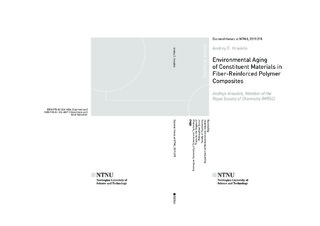| dc.contributor.advisor | Echtermeyer, Andreas | |
| dc.contributor.advisor | Vedvik, Nils-Petter | |
| dc.contributor.author | Krauklis, Andrejs | |
| dc.date.accessioned | 2019-09-04T11:21:25Z | |
| dc.date.available | 2019-09-04T11:21:25Z | |
| dc.date.issued | 2019 | |
| dc.identifier.isbn | 978-82-326-4027-0 | |
| dc.identifier.issn | 1503-8181 | |
| dc.identifier.uri | http://hdl.handle.net/11250/2612463 | |
| dc.description.abstract | Fiber-reinforced polymer (FRP) composites have seen a rapid rise in use in the past 50 years due to their high strength, stiffness, relatively light weight and relatively high corrosion resistance, especially when compared with more traditional structural materials such as steel and aluminum. Composite materials are widely used in structural applications in marine, offshore and oil & gas industries. A typical design lifetime of offshore FRP structures is 25 or more years in direct contact with water leading to some deterioration of the material properties. Knowing and forecasting the extent of the material property deterioration in water is of great interest for designers and users of the offshore FRP structures. The environmental durability becomes a limiting factor in the use of composites for structural applications, since the superior material properties are compromised by the uncertainty of the material interaction with the environment.
Each of the composite constituents (matrix, fibers and sizing-rich interphase) is affected differently by interaction with water molecules. It is therefore of high importance to understand the degradation severity and mechanisms of each of the constituent material due to aging in water. The materials studied are amine-cured epoxy matrix, R-glass fibers and the epoxysilane-based sizing-rich composite interphase, which, combined, constitute the fiber-reinforced composite laminate. Degradation mechanisms for each constituent material were identified, and novel tools, i.e. models and methods, were developed for prediction of long-term properties of composite materials and its constituents. These practical tools are to be of assistance in partially substituting the rigorous physical testing procedures in the state-of-the-art situation. Prediction of long-term properties of composites should significantly reduce costs associated with extensive testing and should already allow a partial transition towards the multiscale modeling approach.
Brief description of the results
A spectroscopic method for true water content determination and monitoring in polymers and composites was developed.
Aging mechanisms and changes in the chemical structure of the amine-based epoxy were investigated. No chain scission (hydrolysis or oxidation-induced) was present, whilst thermo-oxidation and leaching occurred. Four unique reactive sites responsible for thermo-oxidation were found. The only mechanism that was important for the strength reduction of the studied polymer was swelling. Mechanical properties of the epoxy could be regained upon redrying the material to the initial water content. An analytical method for predicting anisotropic swelling in composites from the swelling of the epoxy was developed and explained.
Aging of glass fibers occurred in two distinct phases: a short-term non-steady-state (Phase I) and long-term steady-state (Phase II). Phase I was very complex and involved many competing processes in parallel, such as ion exchange, gel formation and dissolution. Phase II was dissolution-dominated. A chemical kinetic model termed the Dissolving Cylinder Zero-Order Kinetic (DCZOK) model was developed for predicting mass loss and a decreasing radius of glass fibers at various environmental conditions.
The sizing-rich composite interphase was degrading due to hydrolysis, resulting in the formation of the interphase flaws. These flaws could further develop into fiber/matrix debondings, matrix cracks and splitting along the fibers. The internal volume created by the flaws and cracks could then be filled with water leading to the observed mass increase of a typical composite.
All known environmental aging mechanisms of the studied composite constituents were systematized and a phenomenologically complete mass balance was presented. Using the mass balance, it was possible to deduce the dissolution kinetics of the sizing rich-composite interphase. | nb_NO |
| dc.language.iso | eng | nb_NO |
| dc.publisher | NTNU | nb_NO |
| dc.relation.ispartofseries | Doctoral theses at NTNU;2019:215 | |
| dc.relation.haspart | Paper 1: Krauklis, Andrejs; Gagani, Abedin; Echtermeyer, Andreas. Near-Infrared Spectroscopic Method for Monitoring Water Content in Epoxy Resins and Fiber-Reinforced Composites. Materials 2018 ;Volum 11.(4) s. 1-14 | nb_NO |
| dc.relation.haspart | Paper 2: Krauklis, Andrejs; Echtermeyer, Andreas. Mechanism of Yellowing: Carbonyl Formation during Hygrothermal Aging in a Common Amine Epoxy. Polymers 2018 ;Volum 10.(9) s. - | nb_NO |
| dc.relation.haspart | Paper 3: Krauklis, Andrey; Gagani, Abedin; Echtermeyer, Andreas. Hygrothermal Aging of Amine Epoxy: Reversible Static and Fatigue Properties.. Open Engineering 2018 ;Volum 8.(1) s. 447-454 | nb_NO |
| dc.relation.haspart | Paper 4: Krauklis A.E., Gagani A.I., Echtermeyer A.T. pprediction of orthotropic hygroscopic swelling of fiber-reinforced composites from isotropic swelling of matrix polymer. Journal of Composites Science (Switzerland), 3(1), 2019, 10-23. | nb_NO |
| dc.relation.haspart | Paper 5: Krauklis, Andrey; Echtermeyer, Andreas. Long-Term Dissolution of Glass Fibers in Water Described by Dissolving Cylinder Zero-Order Kinetic Model: Mass Loss and Radius Reduction.. Open Chemistry 2018 ;Volum 16.(1) s. 1189-1199 | nb_NO |
| dc.relation.haspart | Paper 6: Krauklis, Andrey; Echtermeyer, Andreas. Dissolving Cylinder Zero-Order Kinetic Model for Predicting Hygrothermal Aging of Glass Fiber Bundles and Fiber-Reinforced Composites.. International Glass Fiber Symposium IGS 2018; 2018-10-29 - 2018-10-31 Is not included due to copyright restrictions | nb_NO |
| dc.relation.haspart | Paper 7: Krauklis A.E., Gagani A.I., Vegere K., Kalnina I., Klavins M., Echtermeyer A.T. Dissolution Kinetics of R-Glass Fibres: Influence of Water Acidity, Temperature, and Stress Corrosion. Fibers (Switzerland), 7(3), 2019, 22-40, In a special issue: Advances in Glass Fibers. | nb_NO |
| dc.relation.haspart | Paper 8: Krauklis A.E., Gagani A.I., Echtermeyer A.T. Long-Term Hydrolytic Degradation of the Sizing-Rich Composite Interphase. Coatings (Switzerland), 9(4), 2019, 263-286. | nb_NO |
| dc.title | Environmental Aging of Constituent Materials in Fiber-Reinforced Polymer Composites | nb_NO |
| dc.type | Doctoral thesis | nb_NO |

